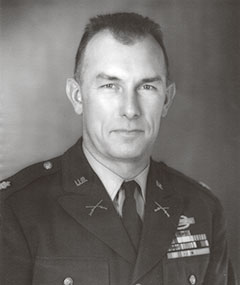On December 16, 1944 by 05:30 a.m. the first German shells landed on the thinly-stretched American defense lines of the so-called “quiet sector”, taking everybody by surprise. The “Battle of the Bulge” had begun!
Between 16th-18th December U.S. soldiers tenaciously resisted the onslaught of overwhelming numbers of German attackers on the hills overlooking the Our. But it became clear that, eventually, they would be overrun.
The evacuation of the civilian population of Diekirch during the “Bulge” Dec 19/20, 1944
A tribute to Captain Harry M. Kemp and to the 109th US Infantry Regiment/28th US Infantry Division
On December 18, the initial “hold at all cost” order was lifted and the commander of the 109th Inf. Rgt., LTC Rudder, ordered the 3rd battalion from the “Our” sector towards the south banks of the “Sûre” to execute a delay fight thru Bettendorf and Gilsdorf towards Diekirch. 3rd Bn commander Major McCoy ordered the attached engineer platoon to destroy the bridges across the “Sûre” to “buy time”. It was up to Captain Harry M. Kemp to transfer the battalion headquarters from Bettendorf back to Diekirch, into the centrally-located “Hôtel des Ardennes”. On Dec. 19, 1944, Cpt. Kemp was directing the operations of the retreating front-line companies thru Diekirch, when the Mayor of Diekirch, Mr. Theis accompanied by Lt. Melchers, Luxembourg State police, came to draw his attention to the precarious fate of the +/- 6.000 local inhabitants and refugees.
Cpt. Kemp’s orders from the regiment were to take the troops to a new position north of Diekirch – they did not mention anything about civilians! Nonetheless, he took the initiative and received clearance from the division (General Norman “Dutch” Cota in Wiltz) to evacuate the town under his supervision! As he sent out Luxembourg police, resistance fighters and a few GIs to warn every household to gather before midnight in the courtyard of the Diekirch high-school, he quickly designed a plan that would not interfere with the military retreat: the road Diekirch-Ettelbruck was exclusively reserved for the troops. As the main Diekirch bridge had been blown-up in September 1944 by the retreating Germans, the only remaining way “out” would be the railroad bridge (today’s “red” rope bridge), though it was already prepared for destruction.
Shortly after midnight, the civilians started getting across the bridge. The engineers held off on firing the demolition charges until all were safely on the other banks. Due to a miss fire, the bridge was only partially destroyed and later repaired by the Germans after capturing the town on December 20, 1944. But the civilian evacuation had worked – thanks to Cpt. Kemp’s unselfish initiative, 97% of the population made it to safety and survived the war.
The Germans were able to keep the town until January 20, 1945, when Diekirch was re-liberated by units of the 5th US Infantry “Red Diamond” division. |

